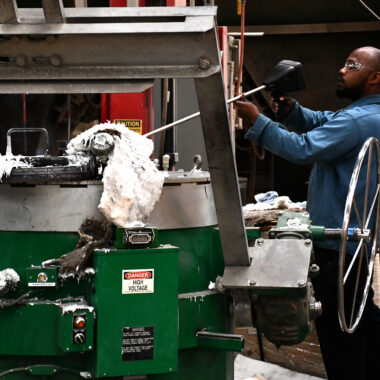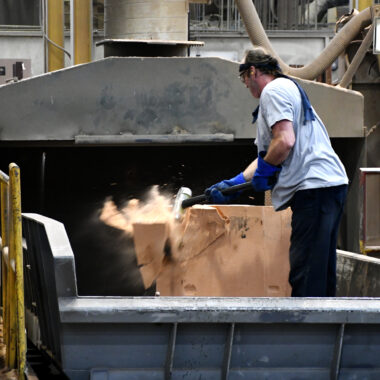The Top Strategies for Aluminum Casting That You Required to Know
In the realm of aluminum precision, casting and experience are vital. Recognizing the subtleties of various casting methods can dramatically impact the high quality and effectiveness of the end product. From the traditional sand casting technique to the complex financial investment spreading procedure, each technique offers distinct advantages that deal with different job demands. As we browse via the leading techniques for aluminum casting, it becomes apparent that mastering these techniques is important for accomplishing ideal results. Let's check out the complexities of these methods and exactly how they shape the world of aluminum spreading.
Sand Spreading Strategy
The Sand Casting Technique is a basic technique in light weight aluminum casting, extensively used for its cost-effectiveness and adaptability in creating intricate steel shapes. This strategy includes creating a mold and mildew made from compacted sand right into which molten light weight aluminum is poured, allowing it to strengthen and take the shape of the mold and mildew. One of the key benefits of sand casting is its capacity to produce intricate geometries with fairly reduced tooling expenses, making it an attractive choice for manufacturers aiming to create one-of-a-kind elements.
In the sand spreading process, a pattern of the last part is pushed right into a fine sand combination included within a flask. As soon as the pattern is removed, a tooth cavity representing the last component's form is left in the sand. Molten aluminum is after that poured right into the cavity, filling up the room and taking on the precise details of the pattern. After the light weight aluminum cools and strengthens, the sand mold is escaped, disclosing the newly cast aluminum component. Sand casting is generally used in different sectors, including automobile, aerospace, and art shops, due to its capability to generate both tiny and large steel components with elaborate styles.

Investment Casting Refine
A complex method used in aluminum spreading is the Investment Casting Refine, known for its capacity to create very outlined and intricate steel components. Likewise referred to as the lost-wax spreading procedure, this method goes back countless years and continues to be a prominent selection in various sectors due to its convenience and precision - aluminum casting.
The financial investment spreading process begins with the production of a wax pattern, which is coated with a ceramic shell to create a mold and mildew. The wax is then thawed out, leaving a dental caries in the shape of the preferred component. Molten light weight aluminum is poured right into the ceramic mold, taking and loading the dental caries on the detailed information of the initial wax pattern.
This technique is preferred for its ability to create complex forms with excellent surface area finish and dimensional precision. It is generally used in the manufacturing of aerospace parts, precious jewelry, and commercial machinery where complex designs are called for. The investment spreading procedure provides high repeatability and can generate get rid of marginal machining needed, making it an affordable choice for lots of applications.
Permanent Mold And Mildew Method
Utilizing a different technique from the Financial investment Casting Refine, the Permanent Mold and mildew Approach in light weight aluminum casting uses an unique strategy for developing steel elements. In this technique, a recyclable mold, normally made from steel or cast iron, is utilized to shape the molten light weight aluminum. The mold and mildew is preheated to a certain temperature level prior to the light weight aluminum is put into it. The heat transfer from the molten steel to the mold and mildew assists in solidifying the aluminum quickly, lowering the cooling time contrasted to sand casting.
Among the essential benefits of the Long-term Mold Approach is the enhanced surface coating and dimensional precision of the spreadings produced. This technique is likewise known for its capability to produce high-strength light weight aluminum elements with consistent high quality. Additionally, the multiple-use nature of the mold makes it a cost-effective choice for medium to high quantity production runs.
Die Spreading Innovation
Making use of advanced production procedures, die casting innovation offers a highly effective approach for producing elaborate light weight aluminum parts. This technique includes infusing liquified aluminum into a steel mold, called a die, at high stress. The die is specially developed to form the light weight aluminum right into the desired form, leading to high accuracy and superb surface area finish.
Die casting offers several advantages. It permits the manufacturing of intricate forms with slim wall surfaces, limited resistances, and smooth surfaces, making it perfect for applications where looks and accuracy are critical. In addition, pass away spreading makes it possible for rapid production rates, reducing overall manufacturing time and costs.

Lost Foam Spreading Method
Die casting innovation's effectiveness and accuracy in creating light weight aluminum elements pave the method for checking out the Lost Foam Casting Method as a complementary manufacturing technique. Lost Foam Spreading, additionally recognized as evaporative pattern spreading, is a technique that utilizes foam patterns to produce elaborate aluminum parts.
One of the crucial advantages of Lost Foam Spreading is its capability to produce complicated layouts with detailed details that might be challenging to achieve with traditional spreading methods. As sectors continue to require websites lightweight yet long lasting components, Lost Foam Spreading proves to be a beneficial method in the world of light weight aluminum casting.
Verdict
In final thought, recognizing the top methods for light weight aluminum casting is critical for achieving high-grade cause the production procedure. Sand casting, financial investment spreading, permanent mold and mildew, pass away casting, and lost foam spreading are all reliable methods for creating light weight aluminum parts with different levels of intricacy. By understanding these techniques, makers can make certain that their products satisfy the preferred requirements and standards for performance and longevity.
From the traditional sand casting technique to the detailed financial investment casting procedure, each method uses one-of-a-kind advantages that cater to different job demands.The Sand Spreading Method is a basic approach in aluminum spreading, widely utilized for its cost-effectiveness and flexibility in producing complex steel forms. Lost Foam Spreading, likewise understood as evaporative pattern spreading, is a technique that utilizes foam patterns to produce complex light weight aluminum components. As markets continue to demand lightweight yet resilient components, Lost Foam Casting proves to be a news valuable method in the world of light weight aluminum spreading.
Sand spreading, investment casting, permanent mold, pass away spreading, and lost foam casting are all effective methods for producing aluminum components with different levels of complexity.